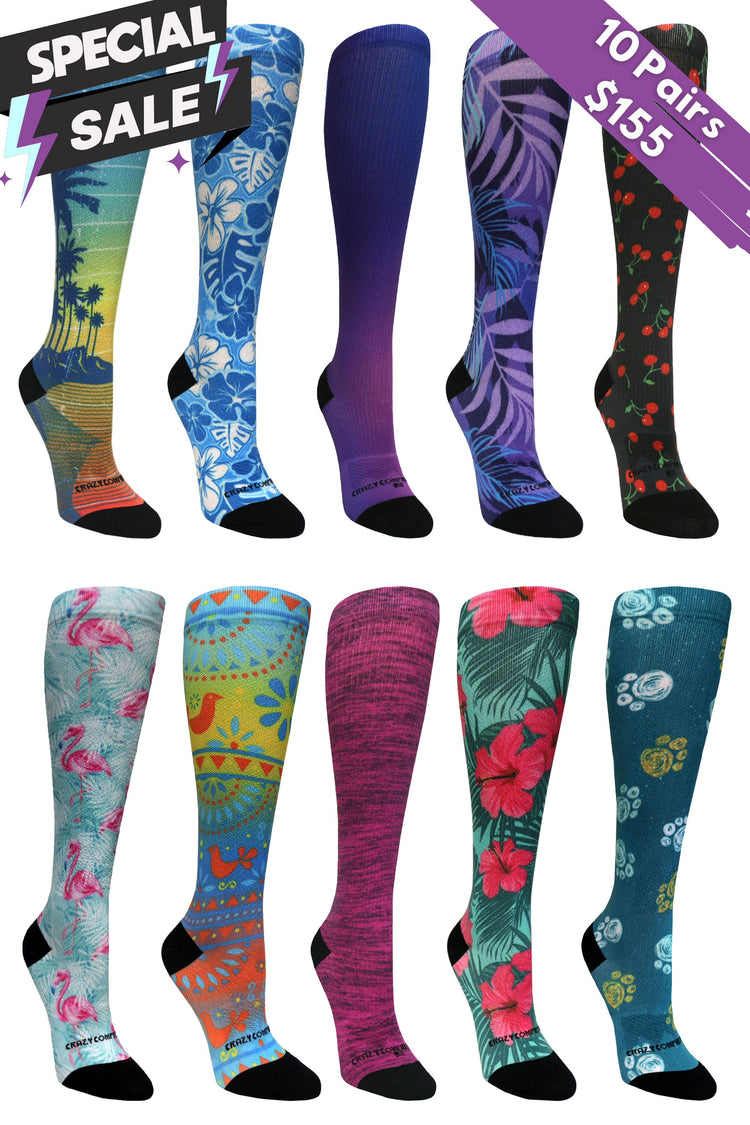Traveling can be exciting, but long flights can take a toll on your body. You've likely experienced swollen ankles, dry skin, and discomfort after hours of sitting still in cramped spaces. One way to combat these issues is by wearing compression socks for flying and long travel. These socks can improve your circulation and reduce discomfort, helping you feel better and refreshed when you land.
How Flying Affects Your Body
Air travel can stress your body and mind, especially on long-haul flights. From the stress of the airport experience to cramped seating arrangements, it's no wonder your body feels the effects. Your legs are especially prone to poor circulation during flying, leading to swelling, bloating, and discomfort. The dry air at high altitudes can leave your skin parched. At the same time, limited mobility makes it difficult for your blood to flow correctly.
Wearing Compression Socks for Flying and Long Travel
Compression socks and compression sleeves are specially designed garments that apply gentle pressure to your legs, promoting better circulation and helping blood flow back to your heart. This is especially beneficial during long flights when you're sitting for extended periods, which can lead to swelling and discomfort.
Compression socks work best when they offer graduated compression, meaning they're tighter around your feet and ankles and gradually loosen as they move up your legs. This design encourages blood to flow upward, reducing swelling, discomfort, and the risk of blood clots like deep vein thrombosis (DVT) or varicose veins. Wearing compression socks during your flight helps refresh your legs and energize you, even after hours of travel.
Benefits of Wearing Compression Socks on Flights
Compression socks offer many benefits for travelers, especially during long flights. Here's how they help:
Reduce Swelling
Long periods of sitting, especially during flights, can cause fluid to pool in your lower legs, leading to swollen ankles. Compression socks help prevent this by gently applying pressure to your legs, improving fluid movement, and preventing fluid retention and swelling. There are compression socks for men and specially designed compression socks for women.
Prevent Blood Clots
Sitting for extended periods during air travel can increase the risk of DVT, a condition in which blood clots form in the legs. Compression socks help reduce this risk by enhancing blood circulation and preventing the blood from pooling and clotting, which can be a severe health concern during long flights.
Improve Comfort and Energy
Compression socks can improve blood flow, which can help reduce discomfort and fatigue in your legs. Promoting circulation, they help keep your legs feeling lighter and less tired, even after long periods of sitting. Cushioned compression socks offer even more comfort, making them an excellent choice if you're looking for extra support on your long flight.
Support Circulation
Compression socks apply graduated pressure to your legs, with the tightest point at the ankle gradually becoming looser as they move up the leg. This graduated compression supports healthy blood circulation by assisting the veins in pushing blood back toward the heart, ensuring efficient blood flow, and reducing the strain on your cardiovascular system during air travel.
Reduce the Risk of Varicose Veins
Traveling, especially over long distances, can exacerbate varicose veins, which can cause discomfort and long-term health issues. Wearing compression socks can help prevent or reduce the progression of varicose veins by improving circulation, which minimizes the risk of your veins swelling and becoming more prominent.
Keep Your Legs Cool
Compression socks, especially those made with moisture-wicking fabrics, help keep your legs cool and dry during flights. The breathable material of cooling compression socks pulls moisture away from your skin, keeping your legs comfortable, even in the confined and often stuffy environment of an airplane cabin.
Possible Side Effects of Compression Socks When Flying
Compression socks offer many benefits, but can wearing compression socks be harmful? Yes, if you misuse them. They can cause discomfort, pinching, or restricted blood flow if they're too tight or don't fit well. Prolonged use without proper guidance may lead to skin irritation or worsened circulation.
To avoid these issues, always choose the right compression level and size, and consult a healthcare professional if you have circulation issues. Compression socks should never cause pain — if they do, remove them and adjust for a better fit.
Avoid compression socks while flying if you:
- Have severe arterial disease or poor circulation, as compression could worsen blood flow.
- Have skin infections or open wounds, as compression can irritate the area.
- Have severe heart or lung conditions, as compression may strain your circulatory system.
- Have allergies to materials like latex, as some compression socks are made with this material.
- Have DVT or advanced peripheral artery disease (PAD). Always check with your doctor before using compression socks.
How to Choose the Right Compression Socks for Travel
When selecting compression socks for a flight, there are a few things to keep in mind:
Correct Compression Level
Compression socks come in various levels, typically measured in mmHg (millimeters of mercury). Look for socks with 15-20 mmHg compression for long flights, perfect for preventing swelling and promoting circulation during extended sitting periods. Medical-grade socks, like diabetic socks with higher compression, are best if you have specific medical needs. Still, non-medical socks are great for most travelers.
Fit and Length
Choose long compression socks that cover your feet and legs. Long socks are necessary for travel, unlike calf sleeves, which don't provide full coverage. They should fit snugly without being too tight or too loose.
Style and Comfort
Remember comfort! Look for compression socks made from breathable materials that are soft and comfortable. And since long flights can be tedious, why not have a little fun with the style? Choose socks that fit your personality. Brighten your long flight with colorful striped compression socks or get in the seasonal spirit with holiday compression socks. They may even lead to a conversation with your seatmate.
Compression Socks for Other Long-Haul Travel
While compression socks are most commonly associated with air travel, they can also be beneficial for other forms of travel and long periods of sitting or standing. Compression socks can provide the same benefits for your legs if you take a long bus ride, train journey, or even on road trips. They can also be helpful for anyone who spends a lot of time standing, such as during long sightseeing tours or at events.
Benefits of Compression Socks for Different Types of Travel
Make sure to leave home with your compression socks. Consider wearing them for other types of travel, too.
- Road trips: They help reduce swelling and discomfort from long hours of sitting in the car, improve blood flow, and prevent leg fatigue.
- Train and bus journeys: Keep blood circulation steady during long periods of sitting to prevent blood from pooling in your legs.
- Sightseeing tours: Offer relief if you spend hours walking or standing, reducing the risk of leg fatigue and swelling.
- Event attendance: Compression socks are ideal if you are attending long events like conferences or concerts, as they help reduce discomfort from standing for extended periods.
- Cruise travel: Compression socks are perfect for cruise passengers who spend long days sitting and walking. They reduce swelling from prolonged inactivity.
Frequently Asked Questions
Should I wear compression socks while traveling?
Yes, wearing compression socks during travel can help improve circulation, reduce swelling, and prevent blood clots, especially on long flights or extended periods of sitting.
When should you not wear compression socks?
If you have certain health conditions, such as severe peripheral artery disease, open wounds, or skin infections, you should avoid wearing compression socks without consulting your doctor first.
What level of compression sock is best for air travel?
Compression socks with a 15-20 mmHg pressure level are ideal for air travel as they help reduce swelling and improve circulation during extended periods of sitting.
Who should not wear compression socks when flying?
People with certain medical conditions, such as peripheral artery disease, severe heart conditions, or skin infections, should avoid wearing compression socks when flying unless advised by a doctor.
What are the side effects of compression socks when flying?
Potential side effects of wearing compression socks while flying include discomfort, skin irritation, and, if improperly fitted, restricted blood flow. To avoid these issues, choose compression socks that fit well, take periodic breaks, always wear a clean pair of compression socks, and consult your doctor for tailored advice.
Can you wear compression socks when driving?
Yes, you can wear compression socks when driving. They help improve circulation and reduce swelling during long periods of sitting.

































Leave a comment
This site is protected by hCaptcha and the hCaptcha Privacy Policy and Terms of Service apply.